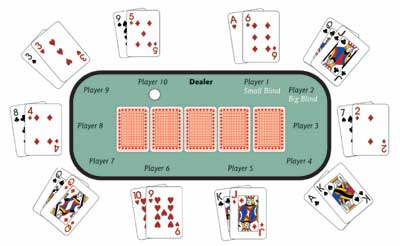How Many Cards Do You Get In Texas Holdem
Posted By admin On 29/03/22- How to Win at Texas Holdem Poker Up until the 2000s, seven card stud was the dominant form of poker throughout many parts of the world. But this changed during the poker boom of the mid 2000s, when Texas holdem became the preferred game for every major tournament.
- Each player gets one card at a time until each player has two cards, both face down. These are known as your hole cards and they are for your use alone when making your final 5-card poker hand. A round of Texas Hold’em consists of a minimum of one and a maximum of four betting rounds. A hand ends when all players but one have folded.
- It depends in part on how many players are in the game, but a general rule is that you should seriously consider folding before the flop if you have two non-pair cards, both less than 10.
It’s not uncommon for people to hear of cheating when they hear the term “card counting”, but the technique doesn’t actually have anything to do with cheating at all. What’s more is that you don’t need to be a math wiz to be able to learn how to do it.
In our fantastic tutorial, we will explain to you how to play Texas Holdem Poker. This covers all the different options that you have as a player, how each h.
Nevertheless, it’s not uncommon for people to want to learn how counting cards works, and in poker specifically, it can be an effective strategy that can give you the edge over your opponents. When you first start learning how to count cards, you only need to get a hang of three simple things, namely Texas Hold’em odds, counting your outs and pot equity. This guide will show you the basics of counting cards so that you can improve your Texas Hold’em game:
How to Count Cards: Counting Outs
Any good poker player needs to be able to count outs. Learning how to count outs will help you improve your game and give you excellent preliminary knowledge before you truly understand how to count cards in poker. So, what is an “out”? The term “out” in the context of poker refers to any card that will make your hand stronger or give you the potential of turning your hand into a winning one. To be able to identify cards that will do this to a hand, you need to have good knowledge of hand rankings. Thankfully, calculating outs is relatively simple:
Remember that counting cards is not an exact science. Unlike the example above, you will never know which cards your opponent is holding. As a result, you need to pay attention to how they play, when they produce their flop cards, how much they are betting while also considering the possible available combinations. Don’t forget that they could always be bluffing!
/improve-at-texas-hold-em-poker-412242_final-5bb26d0346e0fb0026dfc3f1.png)
Counting Cards: Poker Pot Equity
You will be able to grasp pot equity when you get the hang of counting cards. It’s a natural extension of card counting and involves calculating the likelihood of your chances of forming a winning hand and thus taking the pot.
There’s a method for calculating pot equity, and it’s known as the “Rule of Two and Four”. It is only applied during the flop and river stages of a round, and that’s because they are the only two stages where more cards are revealed. Here the two simple rules within the Rule of Two and Four:
For example, if you had a draw with 12 possible outs on the flop, you would multiply this by four, giving you approximately a 48% chance of getting the right cards to complete your hand. Furthermore, if you are left with 12 outs on the turn, you would have a 24% chance of completing your hand. Calculating your pot equity can be extremely useful when it comes to determining your moves in a game, reducing the number of needless bets you have to make, and proving the importance of learning how to count cards in poker.
The underlying mathematics of this process is complex, but worth knowing if you want to calculate your equity on the fly. Say you have 10 outs on the turn with 46 cards left in the deck, your probability of hitting is 10/46. By imagining that there are 50 cards in the deck, the probability is 10/50, or 20/100, meaning that your chance of getting the pot equity is 20%.
However, the real probability of 10/46 is expressed as 21.7%, which would mean that the number of outs would have to be multiplied by 2.174 – an incredibly hard sum to do when your opponent just raised €50! Regardless of how you choose to use it, if you want to learn how to count cards, you need to know how to judge your pot equity.

Texas Holdem Card List
Texas Hold’em Odds: Hole Cards
To give you a greater understanding of how difficult it can be to predict an opponent’s hand, as well as giving you a better insight into how to count cards effectively, it’s important to know the odds of receiving some of the best and worst hole cards. In addition, we’ll give you the probability of winning with these hands in a standard four-person game.
How Many Cards To Deal In Texas Holdem
Now that you’ve learned the ins and outs of how to count cards, pot equity, and Texas Holdem odds, why not put your skills to the test of one of our online poker games?